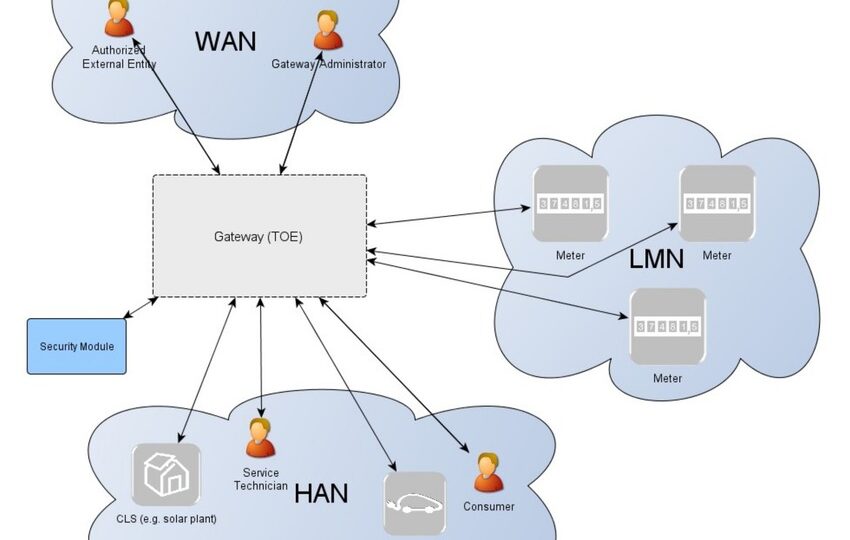The Internet of Things (IoT) has made our current model of smart metering possible, by enabling machine-to-machine communication using a low data rate and low bandwidth for low battery consumption.
However, this communication would not be possible without gateway devices that sit in the middle and allow these devices to connect to the internet. This is why it is important to know how to choose the best gateway for your smart metering technology.
Understanding Smart Metering
Smart metering represents a huge opportunity for large-scale energy savings. They facilitate near real-time energy monitoring and management and hence utilities can charge different prices for consumption according to the time of day and the season to influence demand response.
Smart metering rollouts aim to increase energy efficiency and reduce emissions decreasing consumers energy demand to enable climate change reductions. This application allows connection to electronic meters and does meter readings in real-time. It enables users to view meters, connect and disconnect to them remotely.
What is a Smart Metering Gateway?
A smart metering gateway is a communication unit that allows you to connect to electricity meters, gas meters, and other types of utility meters.
Like all IoT devices, meters require a connection to a network. But they don’t always transmit directly to the cloud. Electronic meters typically transmit data to a local gateway, which aggregates data from all meters in a geography and then forwards it to the cloud, where providers and customers can access it through a platform.
Smart metering gateways are required to collect accurate and aggregate unfalsifiable energy data from energy meters and convert them to meaningful data to be displayed on meter data management (MDM) systems on cloud.
In the EU, the European Energy Directive (EED) has gone into effect aiming to increase energy efficiency 32.5% by 2030 requires to install smart meters and smart metering gateways. These devices, once fully installed can be used to give accurate data about what you should expect to be billed and also give a breakdown of your bills.
LTE Cat 1 Gateway for Smart Metering
In deploying advanced metering infrastructures cellular gateways are widely used making use of networks such as LTE. LTE Cat 1 is a technology that is specifically designed for Machine to Machine (M2M) IoT applications and has applications in smart metering due to its high-speed downlink and uplink.
The following gateway functions need to be considered in smart metering implementations. Eclipse LTE Cat 1 Gateway can be a good example to evaluate smart metering gateway functionalities
- Communication between field devices and remote servers
One of the factors to be considered is gateways ability to transparently relay communication between field meters and remote servers using cellular networks. Cellular gateways allow massive installation of smart meters and smart metering gateways that involve deployments spanning widespread geographical areas. Eclipse LTE Cat 1 Gateway meets stringent functionality requirements in the distribution grid with ubiquitous coverage, low end-to-end latency, high throughput.
- Remote updating
Eclipse LTE Cat 1 Gateway uses over the air protocol (OTAP) to remotely distribute new software, set configuration and update encryption keys of the device. It is a key functionality for utilities to mass manage their meters.
- Support other IoT verticals
Eclipse LTE Cat 1 Gateway can be applied in multiple use cases such as smart metering and smart lighting. The gateway supports more than one type of application. Hence utilities can repurpose the gateway and this makes the device cost-effective.
- Architecture
Eclipse LTE Cat 1 Gateway has multi-threaded platform that optimizes performance.
- Supporting various protocols
Smart meters use data communication protocols that often vary by region. One of the most commonly used protocols is DLMS/COSEM for electricity metering and M-Bus for water metering. Eclipse LTE Gateways offer a wide variety of meter reading protocols including DLMS/COSEM, M-Bus, Euridis etc.
Advantages of smart metering and advanced metering infrastructures
Usage of Advanced Metering Infrastructures (AMI) involves various benefits.
- Research done in 2013 showed deployment of smart meters reported significant reduction of electric consumption and increased energy efficiency. This can be very useful in cutting down user consumption and managing demand response.
- The monitoring capability provided by smart metering infrastructures keep both consumers and energy providers updated on how the billing is done.
- Detect disruption quickly. Smart metering systems detect changes in current and voltage and detect power disruption quickly.







